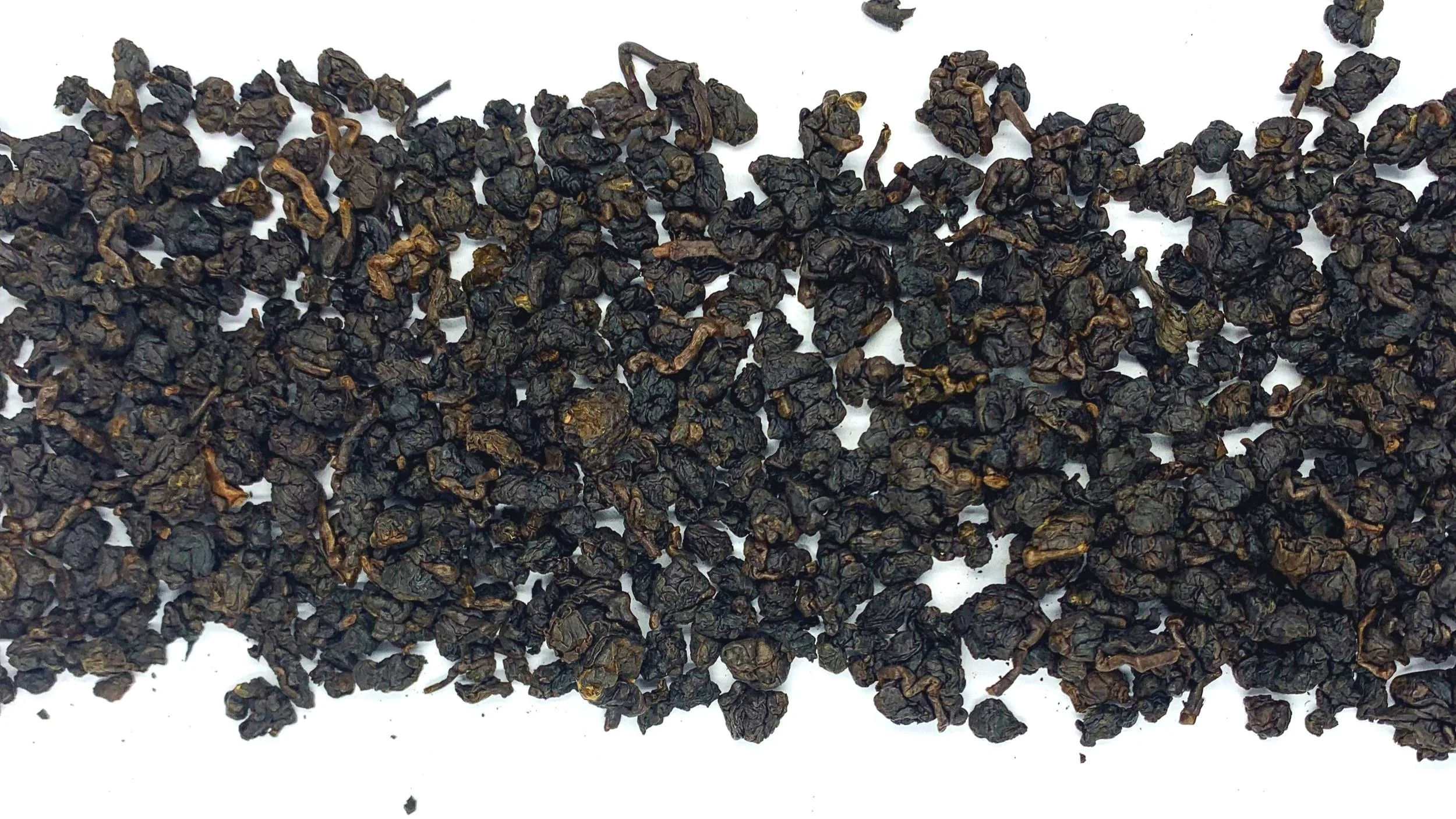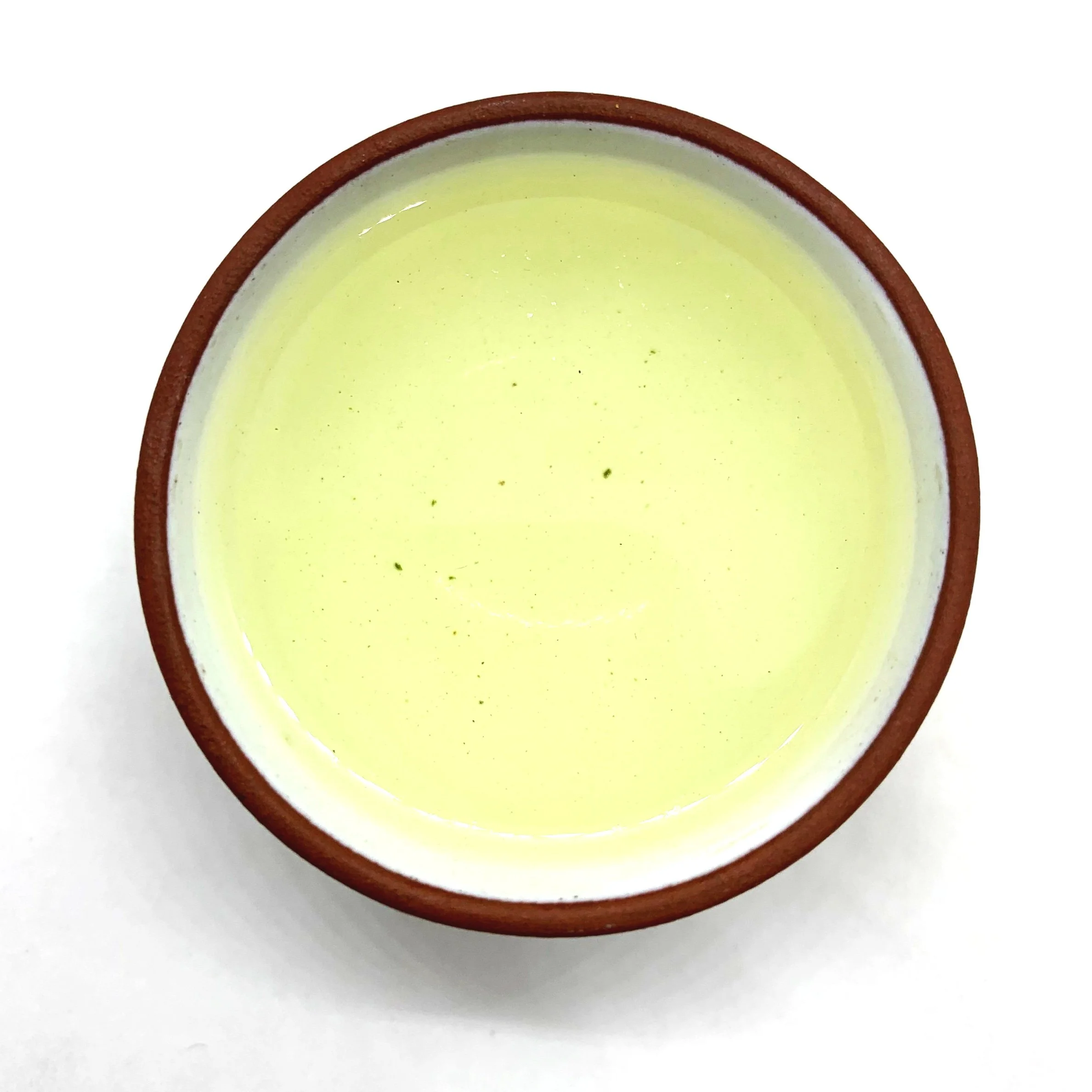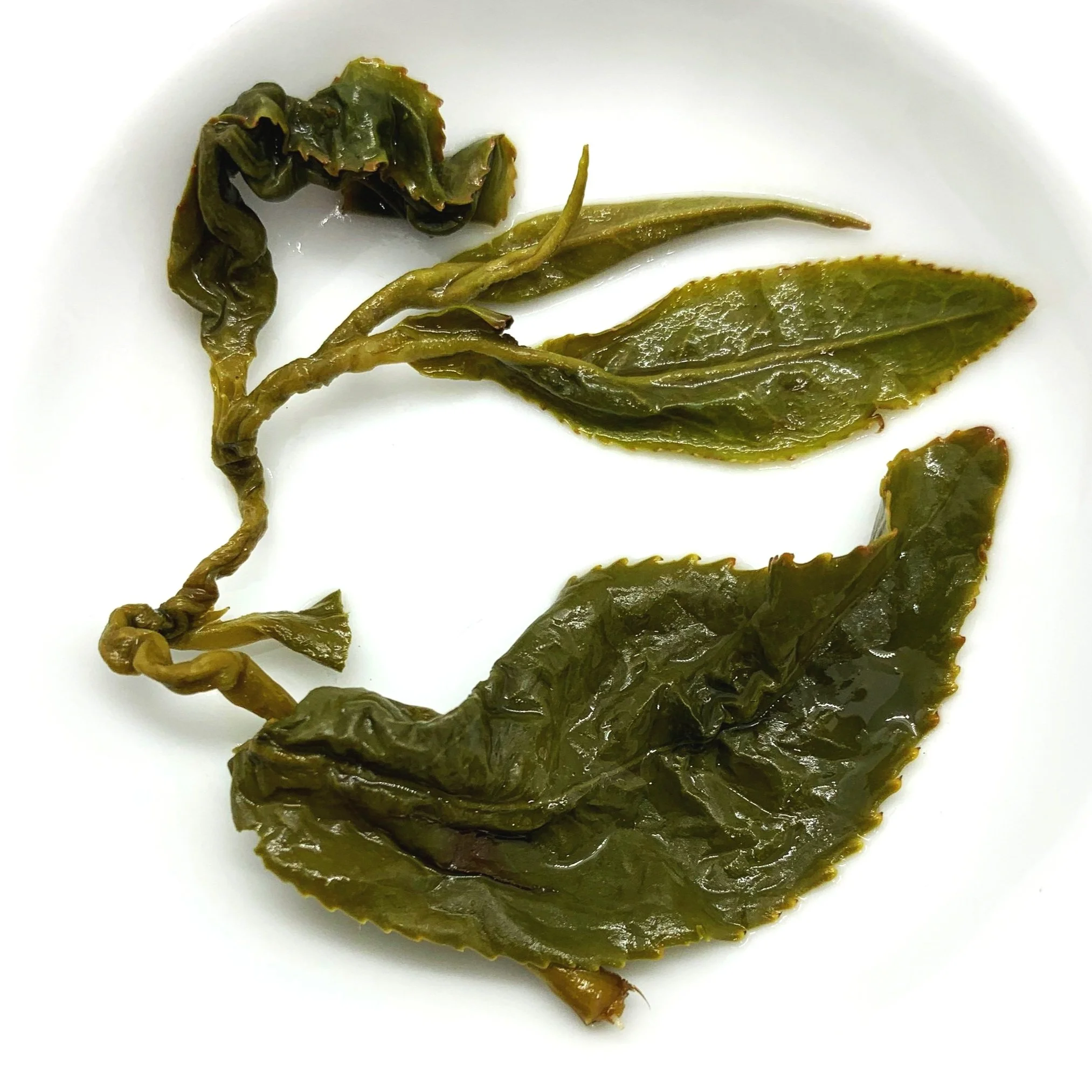Da Yu Ling (大禹岭)
Da Yu Ling (大禹岭)
Hailing from one of the highest elevation tea gardens in the world, this lightly oxidized Taiwanese oolong is bursting with astounding floral flavors. As with other high mountain teas, the more challenging growing conditions and shorter season cause the tea bushes to develop concentrated nutrients in their leaves, resulting in richer and more complex brews. The tea is exceedingly smooth, with a powerful floral aroma and persistent cha qi. We have been working with Mr. Chang for 5 years now, and every harvest this is one of the most highly sought after oolongs we buy.
Origin - Hualien County, Taiwan
Harvest - Spring 2024
Elevation - 8,000 feet
Varietal - Qing Xin (青心烏龍)
Tea Maker- Mr. Chang
Tastes Like - Floral Bouquet, Ghee, Light Tropical Fruits
Sold in one ounce increments
Origin Of The Name “Da Yu Ling (大禹岭)”
The name "Da Yu" comes from the Chinese myth "Great Yu Who Controlled the Waters” (大禹治水). Yu the Great (“Da Yu” 大禹) was a legendary king in ancient China who established the first Chinese Dynasty, the Xia dynasty. He introduced flood control in ancient China, therefore helping to alleviate the suffering caused by one of the greatest recurring natural calamities known to humanity since ancient times.
In Chinese, “ling” (岭) means “ridge” and so the high-mountain tea known as Da Yu Ling is tea that is grown in the Da Yu Ridge area. Da Yu Ridge is a mountain pass where the main line of the Zhongheng Highway (中横公路) in central Taiwan passes through the east-west watershed of the main ridge of the Central Mountains. As the Zhongheng Highway was excavated by hand during the construction, and the geological terrain was dangerous, construction in this area was difficult. The difficulty is no less than that of the ancient Chinese king "Da Yu" who controlled the floods, so it is named "Da Yu Ridge."
Growing Location Of Da Yu Ling Oolong Tea
The Da Yu Ling oolong tea growing area is located on Hehuan Mountain (合欢山) in Taiwan, which is at the intersection of Nantou (南投县), Taichung (台中市), and Hualien counties (花莲县). The altitude of Da Yu Ling is above 2,200 meters. It is the oolong tea-producing area with the highest growing altitude in the world, and is considered one of the premier high-mountain oolong growing locations.
Da Yu Ling tea is favored by many tea lovers, and is known as the "High Mountain Tea King." Due to the fact that the tea trees grow on a ~2,600-meter-high mountain, which is cold and has a large variability in temperature, the growing conditions are unique. In this environment, the tea tree grows slowly, so the tea is tender, the nutrients can become concentrated, and the taste of the tea will be sweet and complex. The local soil conditions are acidic and with good drainage.
In 2015 the government of Taiwan began to reclaim many of the highest elevation tea farms on the Da Yu Ridge area due to concerns over soil erosion and environmental biodiversity. Farms between 95K and 108K on the Zhongheng Highway were all reclaimed by the government, but there are still farms between 88K and 95K that produce excellent quality Da Yu Ling. Our Da Yu Ling comes from a farm located at the 95K marker at an elevation of 2,400 meters.
Taiwanese Oolong Tea
Of all types of tea, Taiwan is best known for its oolong (wulong) teas. Oolong makes up around 90% of all tea produced in Taiwan. In Taiwan, there is a wide range of various altitudes and microclimates among the different tea growing regions, which results in many different styles of Taiwan oolong teas. The top oolongs coming out of Taiwan can easily be considered among the best in the oolong category worldwide.
Taiwanese Oolong History
Due to Taiwan’s proximity to Fujian Province in mainland China and the fact that Fujian is such an important location for oolong tea, it is no surprise then that Taiwan oolong tea has its roots in Fujian. Despite this history, the tea-making process in Taiwan has changed and become unique during the more than 200-year history of Taiwan’s tea industry.
During the Qing Dynasty, Taiwan’s population increased significantly due to immigrants from mainland China, and it was during this time that Taiwanese tea took root. In 1810, a Fujian tea merchant named Ke Chao (柯朝), attempted to grow tea from seed in Taipei County (台北县) and was successful. After this, tea planting started to become widespread in Taiwan.
In 1858, British and French invasions in mainland China resulted in the Treaty of Tianjin, which stipulated Taiwan as an international trade port. British businessman Jardine Mantheson from Hong Kong sent people to Taiwan to purchase crude tea.
Fujian tea makers originally brought the technique of strip-shaped oolong tea from Fujian to Taiwan. In 1885, two tea makers by the names of Wei Jingshi (魏静时) and Wang Jinshui (王锦水) were well known for bringing the method of fragrant, strip-shaped oolongs to Taiwan, basically the same style of oolong as Wuyi Rock Oolong tea and what is currently the style of Baozhong oolong tea.
In 1868, British businessman John Dodd was impressed by Taiwanese crude tea products and began shipping it to Fuzhou each year for processing and refining. Tea masters from Fuzhou also went to work in Taiwan and various tea production equipment was brought over. It was around this time that Taiwanese oolong tea was shipped to the West for the first time. By 1873 the Taiwanese oolong industry began to flourish with foreign firms competing to buy oolong from Taipei, causing the price of Taiwanese oolong tea to steadily rise.
From 1939 to 1941, two other well-known tea makers, Wang Taiyou (王泰友) and Wang De (王德), passed on the tea leaf kneading skills of Anxi, Fujian to others in Nantou County, Taiwan. At this time, the famous style of oolong known as Dong Ding Oolong (冻顶乌龙) began to gradually evolve into its rolled-ball appearance, and this was coupled with the delicate art of tea roasting.
Since about 1980, high mountain tea (高山茶) has become popular in Taiwan. Tea makers gradually adjusted the tea making method of common oolongs such as Dong Ding oolong, along with a trend towards less roasting in the tea-making process, so as to maintain the fresh mountain flavor of the tea.
Taiwanese Oolong Cultivars
A tea cultivar (i.e. “cultivated variety”) is the result of one of the two tea varieties (Camellia Sinensis var sinensis or Camellia Sinensis var. assamica) that has been selectively bred for certain characteristics. A certain cultivar can then be used with specific tea processing methods to result in specific tea styles. Sometimes specific styles are also associated with specific tea growing locations as well. Each style of tea may have a special name, a name related to the growing location, or may just go by the name of the cultivar itself.
Around 1900 Taiwan was under Japanese occupation, during which time a research institute was created that was called the Taiwan Tea Research and Extension Station (TRES). TRES was created to develop cultivars and educate tea farmers. TRES continued functioning post-occupation and has been responsible for the creation of many of the popular Taiwanese cultivars in use today.
The following are the main Taiwanese oolong cultivars:
Qing Xin (青心) - Qing Xin is one of the most widely used cultivars in Taiwan and also one of the highest quality. It is said to have originated in Jianou City (建瓯市), Fujian Province. Qing Xin is also known as Ruan Zhi (软枝), which means “soft stem.” Qing Xin is usually the cultivar used for Dong Ding, Baozhong (a fragrant strip-shaped oolong), and most of the high-mountain oolongs (Da Yu Ling, Alishan, Lishan, etc.). Qing Xin can also be seen as a category of similar cultivars since there are several “Qing Xin” cultivars.
Qing Xin Da Mao (青心大冇) - Qing Xin Da Mao is not as popular as Qing Xin. It is mostly used for Oriental Beauty oolong and has a sweet, honey flavor.
Jin Xuan (金萱) - Jin Xuan is another of the most well-known Taiwanese oolong cultivars and is often sold by its cultivar name, which means “Golden Lily.” Jin Xuan is known for its creamy mouthfeel and milky aroma “nai xiang” (奶香). There are many “milk oolongs” on the market that are artificially flavored, however, high-grade Jin Xuan naturally has the milky flavor without any adulterants. Jin Xuan is popular amongst lower-elevation farmers, but is also grown by high-mountain farmers on Alishan Mountain. It tends to be cheaper than Qing Xin Alishan.
Cui Yu (翠玉) - “Jade Oolong” is usually sold by its cultivar name. This cultivar is very popular in Asian markets, and is only grown at lower elevations (the stems contain too much water for high-mountain growth). Cui Yu yields better than Qing Xin and its flavor is more towards the floral end of the spectrum and is less creamy than Jin Xuan.
Si Ji (四季) - “Four Seasons Oolong” (or Four Seasons of Spring “Si Ji Cun” (四季春)) is primarily grown at lower elevations and used to create greener oolongs (i.e. low oxidation). It is known to produce fragrant spring-like crops all year round and can even be harvested up to six times per year with its fast growth rate. Si Ji usually has a stronger fruit flavor and aroma than the other Taiwanese cultivars.
Tie Guan Yin (铁观音) - The Taiwanese Tie Guan Yin cultivar is processed differently from the well known Tie Guan Yin of mainland China. The Taiwanese version is usually roasted and sometimes aged, and it is the most expensive Taiwanese cultivar.
Fo Shou (佛手) - Fo Shou is another oolong that is also popular in mainland China and is sold as its cultivar name. It is known for its very large leaves.
Bai Mao Hou (白毛猴) - This is a cultivar that is usually used for Oriental Beauty oolong.
Taiwanese Oolong Tea Processing
Picking 采摘
There are two types of tea picking: mechanical-picking and hand-picking. Generally, tea gardens with lower altitudes will choose "mechanical harvesting" to reduce labor costs, but some high mountains will also consider the mechanical harvesting of mature tea leaves.
Most of the tea gardens at high mountain altitudes choose to hand-pick the tea leaves, which can reduce old leaves or excessive branches and maintain the quality of the tea.
Withering 萎凋
(Solar Withering 日光萎调→ Indoor Withering 室內萎凋) The freshly harvested tea leaves contain a lot of water (75% to 80%). After the tea leaves have withered, the water will dissipate and evaporate by 8% to 12% due to the rising temperature of the leaf surface. The oxidation reaction on the leaf surface will start to change the leaves.
Solar Withering This means that the tea leaves, after being picked, are usually set out in the sun to oxidize and let the water content reduce. After the water partly evaporates using sun withering, the leaves will give off a nice scent.
Indoor Withering The tea leaves are flattened on a shelf indoors to an appropriate thickness, and then the leaves are lightly flipped at an appropriate time (requires a lot of standing work). Next is to wait for the tea leaves to slowly drain to remove the bitterness and astringency so that the tea leaves will have a pleasant aroma and a sweet taste.
Laying and Tossing 做青/摇青
After the tea leaves have withered, they must be stirred in a timely manner and rotated in a machine (or manual-stirred as an alternative) to rub the leaf cells, so that the polyphenol oxidase and various tea polyphenols come into contact with other tea polyphenols, and an enzymatic oxidation reaction occurs.
Stir Fixation 炒青
Stir-frying is a turning process that links the previous step to the next, and it is also an important step in the formation of the oolong tea’s endoplasmic aroma. The effect of stir-frying on oolong tea is similar to that of green tea, which inhibits the activity of enzymes, prevents the leaves from continuing to oxidize, and ensures the lasting quality of the oolong tea.
Rolling 揉捻
The purpose of kneading is to inflict stress in a controlled way and essentially destroy the cell tissue of tea leaves to a certain degree. This also results in the juices of the tea leaves getting kneaded out which facilitates oxidation. This way the tea leaves are tightly rolled into strips for easy storage. The degree of rubbing and stress caused to the tea leaves will create different tea flavors due to the natural stress-response of the plant tissue.
“Breaking up” 解块 → Initial Drying 初干 → Mass Kneading 团揉 → “Breaking up” 解块
After kneading, any clumps that have formed are broken-up and placed on a large drum to quickly dry at high temperatures. Then, they are poured onto a cotton cloth and pressed into balls. After the next step of rolling and kneading, clumps are broken-up and separated, and these steps are repeated 3 to 8 times.
Screening 筛分
After several repetitions of the above steps, the oolong tea has formed a spherical or hemispherical shape. At this time, it is necessary to use "mechanical pick-up" and then "manual pick-up" to remove excess tea branches and tea stalks.
Re-roasting 复焙 → Post-baking 后烘焙
The dried tea leaves must be roasted and dried to keep the tea leaves at a certain degree of dryness. During the baking operation, different degrees of baking temperature and the number of times baked can be varied to provide the resulting oolong tea with different flavors. The degree of baking can vary from light to heavy.




